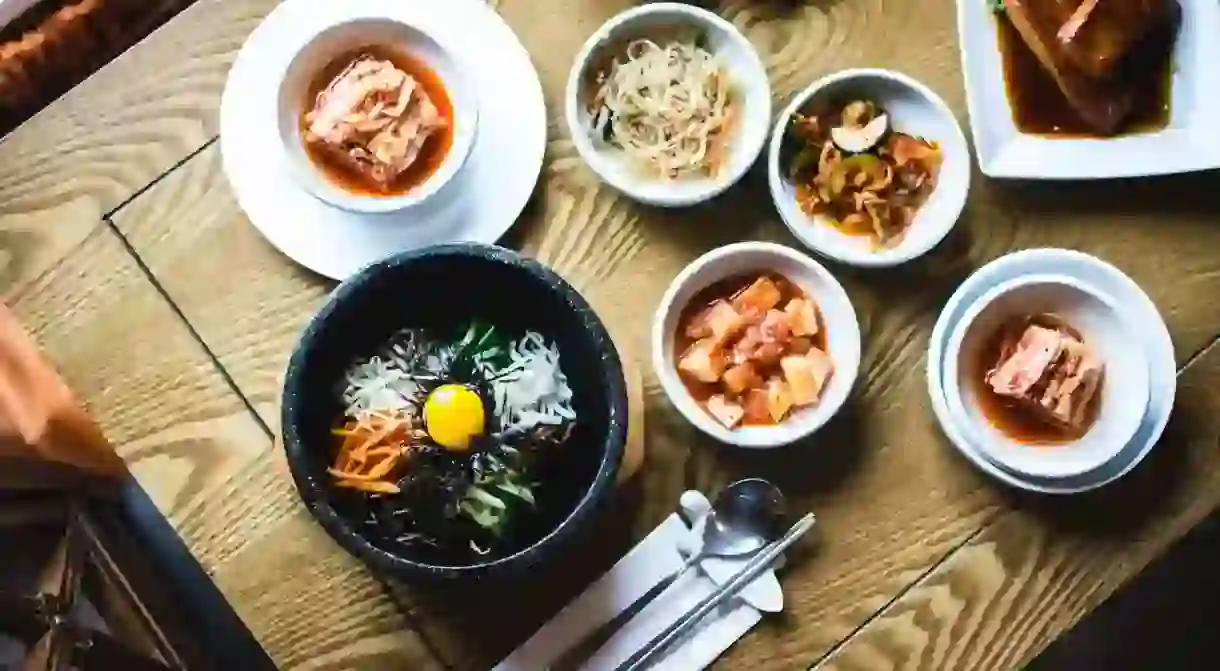Where to Find the Best Bibimbap in Seoul

Bibimbap, rice topped with vegetables, beef, sesame oil, gochujang (red pepper paste) and an egg, is one of Korea’s most representative dishes. It symbolizes the ancient Korean philosophy of obangsaek, which harmonizes nature with the human body. It’s also pretty darn tasty, too. Treat your taste buds (and spirit) to the delicious and nutritious flavors of the iconic dish at these Seoul-based bibimbap establishments.
Gogung (고궁), Seoul
Restaurant, Korean
A popular restaurant among tourists and older Koreans due to its highly traditional Korean ambiance, Gogung has specialized in bibimbap since its establishment some four decades ago. With live performances of traditional Korean music every evening and staff that dress exclusively in hanbok (traditional Korean clothing), Gogung lives up to its name, which literally translates to “old palace.” Don’t be fooled into thinking that Gogung is your typical tourist trap, however – it’s also regularly frequented by Korean diplomats. Their wide variety of bibimbap ranges from classics, such as Jeonju and dolsot bibimbap to specialty dishes such as nakji (octopus) and yukhoe (beef tartare) bibimbap.
Jeonju Jungang Hoekwan (전주 중앙 회관), Seoul
Restaurant, Korean
Despite its no-frills interior, Jeonju Jungang Hoekwan is often listed in just about every Seoul guidebook thanks to the unique flavors of its bibimbap dishes, which are richer, slightly sweeter, and undoubtedly more intense than those served in other establishments. Founded in 1956, the restaurant is most known for its delicious Jeonju-style bibimbap, which originates in Korea’s culinary capital. Jeonju Jungang Hoekwan also does a great dolsot bibimbap, which consists of rice made with beef broth and flavored soy bean paste, and is cooked in a pagodite stone pot until the bottom is slightly scorched.
Manna Bunshik (맛나분식), Seoul
Restaurant, Korean
A bit off the radar (not to mention the beaten path), Manna Bunshik is a small, cozy restaurant tucked into an obscure alleyway in Wangsimni. Because of its location and unique take on bibimbap, it is particularly popular among the numerous students in the area. Their cheesy dolsot bibimbap is the stuff comfort food is made of and is well worth the trip. Just don’t ask about the calories.
Mokmyeoksanbang (목멱산방), Seoul
Restaurant, Korean
Established by the Seoul metropolitan government in an effort to promote Korean culture and cuisine, this gorgeous hanok restaurant is named after the ancient Mokmyeok Mountain, which is known today as Namsan. The traditional wooden house boasts a small yet polished interior with warm lighting and a welcoming atmosphere. With metal bowls and wooden trays, the décor is quintessentially Korean; the aesthetic is further enhanced by the brass kettles from which tea and makgeolli (rice wine) are served. If weather permits, enjoy al fresco dining and the accompanying view of Myeongdong and N Seoul Tower.
Ondal (온달), Seoul
Restaurant, Korean
One of just a handful of Korean restaurants to be found in Seoul’s luxury hotels, Ondal at the Sheraton Walkerhill Hotel offers spectacular views of the Han River. The fine-dining restaurant prides itself on its rich legacy, having hosted a number of politicians and diplomats such as the members of the Korean G20 summit, and basing its menu on the traditional royal cuisine of the Joseon Dynasty. Its bibimbap is created with ingredients of the highest quality – all vegetables are fresh and organic – and prepared using a combination of modern and classic techniques sourced from historical research.
Toetmaru Doenjangyesul (툇마루 된장예술), Seoul
Restaurant, Korean
Combine two of Korea’s most iconic dishes, and you get doenjang (fermented soy paste) bibimbap. Both tasty and nutritious, this unique cuisine is a popular item at Toetmaru Doenjangyesul, an Insadong institution that specializes in doenjang dishes. To best enjoy it, scoop out spoonfuls of the simmering stew on top of the barley rice and stir it up gently with the accompanying vegetables. As doenjang can be too bold in flavor for many, start with less and add more to taste.
Sae Byeok Jib (새벽집), Seoul
Restaurant, Korean
Known to most as a galbi (steak) restaurant, Sae Byuk Jib also serves up a mean yukhoe – or raw beef – bibimbap. Though this Korean delicacy is undeniably an acquired taste, even for Koreans, Sae Byuk Jib’s yukhoe bibimbap is renowned among food critics and locals. The bibimbap also comes with a side of seonjitguk, a hearty soup made from coagulated animal blood – another distinctive, daring dish that richly rewards those bold enough to try it. The menu at this restaurant is offered separately in English for Western tourists.
Jeonju Grandma Yu’s Bibimbap (전주 유할머니비빔밥), Seoul
Restaurant, Korean
Perhaps one of the most authentic Jeonju bibimbap dishes in Seoul is made at Grandma Yu’s, a popular eatery that has been serving loyal patrons for the past 40 years. A warm, humble interior reminiscent of restaurants of the 1960s, attracts droves of diners on a daily basis. For a mere 6,000 won (about US$6), you can fill your belly with tasty bibimbap and all the banchan (side dishes) you can eat.













